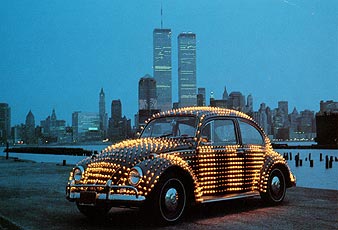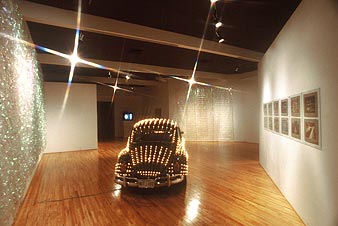One Man’s Bright Idea
By Elisa Turner
Special to The Herald
The Miami Herald
Living Today
Monday, April 13th, 1987
Artist Eric Staller’s Lightmobile is not just another flashy car.
Not exactly priced for a quick sale. For that dazzling sum, you could buy a Maserati or an Alfa Romeo. Why throw it away on a 20-year-old Beetle? This is no ordinary Volkswagen, but one transformed into a magically glitzy work of art. It’s called the Lightmobile, and was created by light artist and self-described enfant terrible of the art world, Eric Staller.
Studded with 1,659 three-watt bulbs arranged in a precise grid across every inch of the car’s body, the Lightmobile flashes and pulses in a dizzying array of patterns. Watching it at night is like watching the marquees of Times Square, the whirling lights of an amusement park or just maybe a glittering UFO fashioned by scheming aliens to resemble a Volkswagen crossed with a discotheque.
Staller was in Miami recently for the opening of his show at the Virginia Miller Galleries in Coral Gables, where his photographs and Lightmobile are on display through April 20. |
 |
FOR SALE: 1967 Volkswagen Beetle. 91,000+ miles.
AM/FM radio. No AC. Runs well.
Guaranteed to attract attention. Only $80,000.
|
 |
"I always think of the sunset as my competition."
Artist Eric Staller
|
|
Not content to see his work housed inside quiet galleries or museums, Staller, a 40-year-old New Yorker, likes to make pieces that can be seen by lots of people in places where art is not usually found. Staller takes his art to city streets, bus terminals, even New York’s East River, where he makes nocturnal cruises aboard the outrageous Bubble Boat, which resembles a space capsule and is fitted out with hundreds of flashing colored lights.
His fantastic modes of transportation excite many who catch sight of them. Thousands of New Yorkers, applauding this audacious Volkswagen, have seen Staller drive all over Manhattan. Rolling down a dark street, the car seems to vanish, replaced by the rhythmic, dancing shapes created by the flashing lights.
One recent evening, hundreds of Miamians saw Staller drive the Lightmobile about town—along Brickell Avenue and through Coconut Grove and downtown Coral Gables.
When the brightly blinking Lightmobile cruised along Main Highway in the Grove, a woman standing on a corner and eating ice cream was paralyzed in astonishment. She held a spoonful in mid-air, her mouth forming a perfect O. In front of a Japanese restaurant. a kimono-clad hostess greeting diners collapsed into gales of laughter when she saw the car.
All ablaze and parked across from the Peacock Cafe on McFarlane Road in the Grove, the Light-mobile drew stares and grins. Staller stood away from his creation, arms folded, smiling as he watched people do double-takes and come over to inspect the car.
“Nice — got anything in blue?” joked a bearded and blue-jeaned musician, adding: “Ever set this thing to music?” A woman driving a red sports car slowed down to give a thumbs-up sign. Bringing his silver Mercedes almost to a halt, a man took a long look and called out an offer to trade his car for the Volkswagen. Staller grinned broadly. A young woman, drink in hand, came dancing up, shouting, “It’s beautiful! It’s outrageous! Are you taking orders?”
Staller was clearly pleased by the reaction. His goal is to make art that shocks, that surprises, and he doesn’t care much whether people easily identify his work as Art or not. He loves to create an experience for the viewer, whom he wants to go home and say, “Honey, you’ll never guess what I just saw!”
Perhaps that’s what you’d expect from a man who describes himself as a “disciplined kid.” Trained as an architect, Staller chafed at the “less is more” instruction he received at the University of Michigan during the late ’60s and early ’70s.
“My sensibility was more is more,” he explains, remembering the outrage with which his eccentric student projects were greeted. Staller arrived in New York at a time when Minimalism was nearing the close of its reign. His puckish response was to produce leopard-skin sendups of the austere boxes designed by Minimalist sculptor Donald Judd. And he made a series of pure kitsch ash-trays, in the shape of an artist’s palette, commemorating the Museum of Modern Art. In those days of cool, serious art, Staller’s iconoclastic sense of humor did not get him very far.
Then, during the late 1970s, a friend left some Chinese sparklers in Staller’s apartment. Staller, an accomplished photographer, began to experiment with timed exposures of himself drawing in space, at night, with the burning sparklers. Graduating from two-minute to 10-minute sparklers, he outlined buildings, tunnels, fountains, himself. He created airy domes, spirals, hoops. In the resulting photographs, the bolts of light seem to have appeared magically: there is no trace of Staller. Finally tired of burned fingers and the time limit imposed by the sparklers, he took to photographing moving patterns of colored, incandescent bulbs.
Eventually he began to create moving light itself, not merely record it on film. At O.K. Harris, a prominent SoHo gallery, Staller installed a carnival-like array of light sculpture, with pulsating hoops, zigzags and figure-8s. Nothing sold. The artist recalls how a curator at the Whitney Museum of American Art described the installation as “disco-madness.” Later, he adds, that museum would invite him and his Lightmobile to opening parties. He sums up the Whitney’s reaction to his work as “They love it, but they’re still wondering if it’s art. . . . Well, that’s not going to make me start doing canvases. I do what I have to do.”
Although Staller has yet to win an unqualified seal of approval from the art establishment, he continues to win smiles and cheers from people on the street. Pursuing his interest in public art, he has won several commissions to create light installations where lots of people can see them.
In December, January and February of every year, his 35-by-40-foot Zig Zag is on display at the Port Authority Bus Terminal in Manhattan. In addition to illuminating manholes, he’s working on a permanent light sculpture to fit along the overhangs of the Performing Arts Center in Anchorage, Alaska. It will be, he says, “a performance of lights.” Encircling the building will be 200 three-foot aluminum rings lighted by 4,000 multicolored bulbs, meant to evoke theater marquees.
Will Miami be next? This is, after all, a city falling in love with its glittering night skyline. According to Virginia Miller, several Staller installations on downtown buildings may be in the offing.
While Staller is excited about upcoming projects, he hasn’t lost sight of the dreams that motivate his experiments with light.
“I always think of the sunset as my competition,” he admits. “That’s what I’m shooting for—something that flies over, that glides by ... Wow....”
His Lightmobile brightens the night
|
